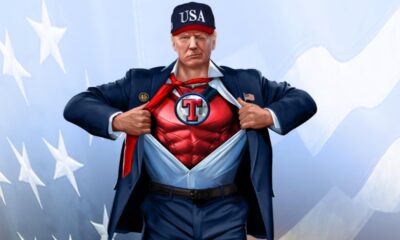Nfts
Token Supremacy Presents a Sensationalized Version of the NFT Boom
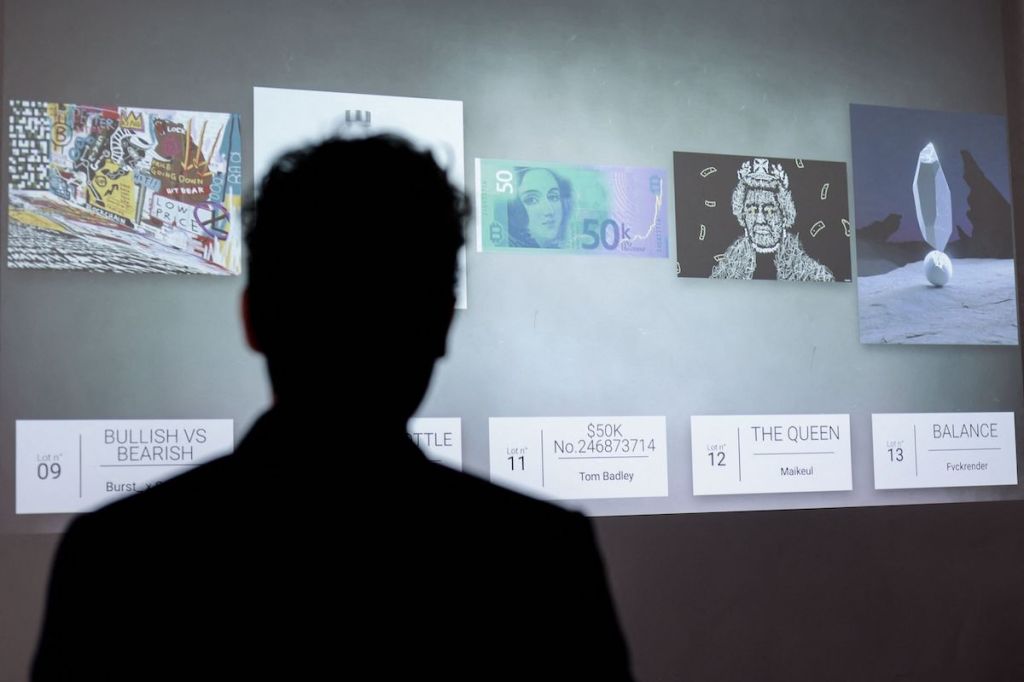
Art and finance have salacious appeal, as writers from Danielle Steele to Steve Martin have found, the latter stating tongue-in-cheek toward the end of his novel, An Object of Beauty: “Art was still art whether it was tied to money or not.” Yet Rembrandt died in penury, as New York Times reporter Zachary Small recounts in the introduction to Token Supremacy, their newly published book on the 2021 NFT market bubble and its aftermath. Small notes this while describing the infamous 17th-century Dutch tulipomania, an apt comparison to the NFT boom, and one that artist Anna Ridler, represented by Nagel Draxler, first made in her video series Mosaic Virus (2018 and 2019), though neither she nor her work are mentioned in Small’s book. Several artists making work about or with blockchain in the technology’s early years addressed its potential and the problems with its underlying financial model: Simon de la Rouviere, Simon Denny, Sarah Friend, Rhea Myers, Martin Nadal, César Andaluz, and Martin Lukas Ostachowski, to name a few. Small’s book recounts the two years of media-driven interest and inflation, but omits this backstory and wider scope, limiting readers’ understanding of what that moment was truly about, and thus, where it might be going.
Related Articles
Across the book’s 12 chapters, Small guides readers through the roller coaster of NFT hype, and its associations with the boom-and-bust and regulatory concerns of cryptocurrencies. Tyler Hobbs, Mike Winkelmann (aka Beeple), Justin Aversano, and Erick Calderon, the founder of generative art platform Art Blocks, are Small’s protagonists of the 2021 boom, taking readers from Christie’s record-breaking auction of Beeple’s Everydays: The First 5,000 Days to the unexpected synchrony, a year and half later, between Art Blocks’ Open House in Marfa, Texas and Sam Bankman-Fried’s resignation from FTX, the now-bankrupt crypto exchange and hedge fund.
Small’s telling contains engaging anecdotes and the occasional digression to art historical antecedents—the evolution of photography and Donald Judd settling in Marfa—that provide obvious cultural references to anchor readers in this emergent technology. But for someone who participated in and was a close observer of the NFT boom, Token Supremacy seems mostly to reiterate popular magazine articles without providing significant new research or insights. This deficiency is underscored by Small’s goal, outlined in the introduction, to contribute to the history of cultural economics and the dynamics of speculation. There is much to say about the gnarly web that links artists, platforms, hedge funds, venture capitalism, regulation, and global finance, but it is not to be found in the four case studies and breezily recounted recent history that form this book. The shortfall between the book’s stated aims and its execution led me to wonder if Token Supremacy had not tried to fulfill the demands of two audiences: to present the art world’s particular usury in its dealings with crypto for those with some knowledge of both art and crypto and, at the same time, provide a Vanity Fair-esque retelling of NFTs that could credibly be a beach read.
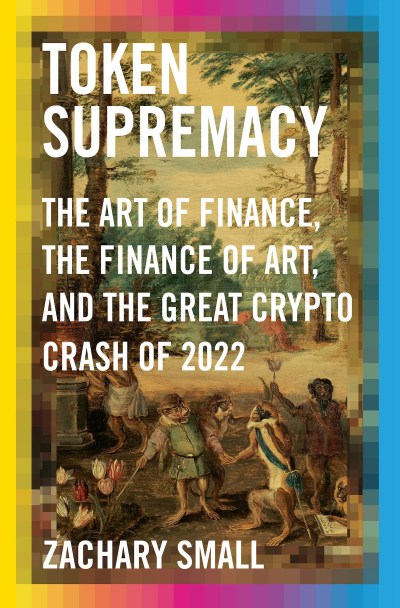
COURTESY OF KNOPF
The demands of the latter lead Small to truncate important events, eliding their deeper complexities. For example, in the book’s first chapter, while Small recounts the desires of and the difficulties faced by the Christie’s employees driving the Beeple auction in March, they bypass telling how, several months earlier, Metapurse, the crypto-focused venture capital fund, sold fractionalized ownership stakes in 20 Beeple works as part of its B20 coin investment scheme. It isn’t mere trivia that Metapurse was then the buyer of Everydays for nearly $70 million, but material to why they had a vested interest in driving up Beeple’s prices. And while Everydays served as a kind of advertisement for B20, those works were not added to the coin investment scheme, as initially reported by Amy Castor. The B20 coin and Everydays would be an ideal case study in speculative tokenomics, and might have been used to explain how insider knowledge and “rug pulls” (where a group draws investors, only to abandon the project) operate within NFTs and crypto markets. Small, however, does not illuminate this connection or its implications.
Further, there is no discussion of the dangers or negative impact that centralized marketplaces like MakersPlace or OpenSea had, nor the model they are based on: the decentralized platform Rare Pepe Wallet, established in 2017, which evolved from the Pepe the Frog, the cult internet meme that went from slacker icon to far right co-optation and, eventually, subsequent reclamation, partly via two Asian projects.
Another important financial feature deserving of greater analysis is resale royalties—Hobbs took in $9 million after an initial $400,000 sale at Bright Moments in 2021, as Small identifies—that were fought for by a group of artists led by Matt Kane in 2020. That recompense was lost during the spiraling of 2022 when marketplaces dubiously claimed they could not sustain it. Similarly, though Small mentions DAOs at regular intervals, unmentioned are the early experiments by artists (like Jonas Lund or Primavera de Filippi), the research initiative and insightful publication led by Furtherfield in London, the 2021 Wyoming legislation recognizing them as legal businesses, or the venture capital funding that was poured into incubators and accelerators. This might have provided insight into how hedge-fund money moved markets within the space, created packages or derivatives, including the possibility of shorting cryptocurrencies, which may have accelerated the crash while still producing a profit for a small percent of financiers. Such investigation would be worthy and meaningful not only to this NFT example but to understanding dangers in current market operations, especially for art’s increasing deployment as an investment vehicle. That would have required more than cocktail parties and dinners with “large burrata salads, wine, and mojitos” ending in “a taxicab headed back uptown” (as Small describes a moment returning from the after-party for Calderon’s opening at Venus Over Manhattan), which sounds more Sex and the City than To Catch and Kill.

Erick Calderon, founder and CEO of Art Blocks.
FOX Image Collection via Getty Images
It is true that, say, Winkelmann and Calderon represent obvious figures within the boom market of that moment, though others like Dmitri Cherniak, Prince Jacon Osinachi Igwe, Sarah Meyohas, or the collective and creative platform DADA could have widened the lens on the impact of surging interest in NFTs and offered a more global perspective. For example, Cherniak is a leading artist who donated the revenue from Dead Ringers: Edition in February 2022 to the NYC Food Bank, providing 16 million meals (a value of approximately $3 million); Osinachi is a Nigerian artist whose work celebrates LGBTQ people in a nation with some of the harshest anti-gay laws and who launched an incubator to help onboard others into digital art; Meyohas produced Bitchcoin in 2015, before Ethereum, and garnered renewed interest in fractionalized work and her market; DADA was created by Judy Mam and Beatriz Ramos to connect participants through a shared digital drawing practice, which developed into an exercise in “the Invisible Economy” that seeks to distribute funds to the community as basic income.
Citations in Token Supremacy are sometimes peculiar and often unclear. Small never cites Zsofi Valyi-Nagy on Vera Molnar, though she is very likely the leading scholar on the artist, nor Amy Whitaker, a prominent author on the art market with research as early as 2019 exploring blockchain use cases for art. The book’s interviews are not identified with date or place, so, when interspersed with information and quotes from other articles, it becomes difficult to discern Small’s contributions from the established information. For example, in Chapter 3, they recount the heist of 309 CryptoVenetians from the Bright Moments DAO and gallery, but despite the appearance of having spoken to participants, the tale seems largely cobbled together from Matthew Leising’s three-part series for Decential Media. In Chapter 2, Small tells the Berlin backstory of the dispute surrounding the first NFT and the McCoys’ Quantum, but this was explored in reporting during the court case. In addition, they write in this section that Sotheby’s head of digital art Michael Bouhanna’s “poor skills of observation and historical knowledge about digital art would push the NFT market towards destruction.” Whatever one may think of Bouhanna or the auction houses, that description seems like overreach.
Sometimes quotes from articles misrepresent the speaker and the article’s original context. At the height of the NFT boom in March 2022, critic Blake Gopnik wrote in the New York Times that Tina Rivers Ryan, then-curator of the Buffalo AKG Art Museum and now editor-in-chief of Artforum, suggested that “the new world of tokens may instead bring about ‘an impoverishment — and not just of digital art, but of art full stop, because it reduces art to being a frictionless commodity,’” with that quote within his text being hers. Small shifts Gopnik’s moderate sounding “may instead bring about” to a definitive and indicative present tense: “NFTs are “an impoverishment…”” This alters Ryan’s likely intent, given that she continues in Gopnik’s article to point out good examples of presenting NFT art. This is the kind of confusion that mitigates confidence in the book overall.
The lack of citations becomes more problematic when alluding to major museums: “The investors who had spent lavishly during the bull market had drained their accounts, leading to embarrassing situations when these crypto ‘millionaires’ who pledged generous donations in exchange for seats on acquisition committees at museums like the Whitney and the Los Angeles County Museum of Art were booted after failing to pay their dues.” In answering questions about this, Angela Montefinise, the Whitney chief communications officer, explained in an email: “At the Whitney, acquisition committee members are invited based on their expertise. We have not had anyone removed from our acquisition committees for any reason, including failing to pay dues. This has not happened.” Similarly, Jessica Young, director of communications for LACMA wrote in an email, “This claim about the museum is absolutely not true and does not align with the standards of the acquisition committee and our institution.”
(Small, for their part, told ARTnews in an email, “That is contrary to what members of their own museum boards told me in the course of reporting this story.”)
Nevertheless, art and money, which are seemingly accessible to anyone, have this elusive quality that cultivates a kind of voyeurism; good narratives allow us behind the veil. Readers will find titillating moments. There are beautiful sentences in which meaning is not particularly important: “There in the digital filing cabinet is a sleepless delirium, an insomnia that turns the art-money into a parade of hallucinations that dance on the fence posts dividing perception and imagination.” Some art world readers will wonder why basics, like the Venice Biennale, are being explained, but may want greater detail on the regulatory blockades, given the ongoing discomfort with increased Know Your Customer and Anti-Money Laundering regulations overseas. Some general audiences may wonder why those museums that famously did collect NFTs during this period aren’t examined in greater depth.
But, as Small writes, “the best strategy for fooling wealthy people into buying art is to make them feel insecure before throwing economic data in their face.” There are a lot of facts and data thrown about in Token Supremacy but they don’t add up to much. For a moment in art deserving of such a cultural studies perspective, it is unfortunate for all the artists, galleries, museums, investors, critics, and audiences of the period that this book is a crash landing.
In the meantime, two other books have been released this year by participants in the current art economy: On NFTs (Taschen) offers an extensive eye-candy overview of many of the leading artists; and Right Click Save: The New Digital Art Community (Vetro) gathers important essays and interviews by scholars, curators, and pioneering and emerging artists about the global, fiscal, and cultural implications of NFTs. The cultural history, however, is yet to be told.
Nfts
NFTs Maintain Upward Momentum, Sales Volume Surpasses $107 Million
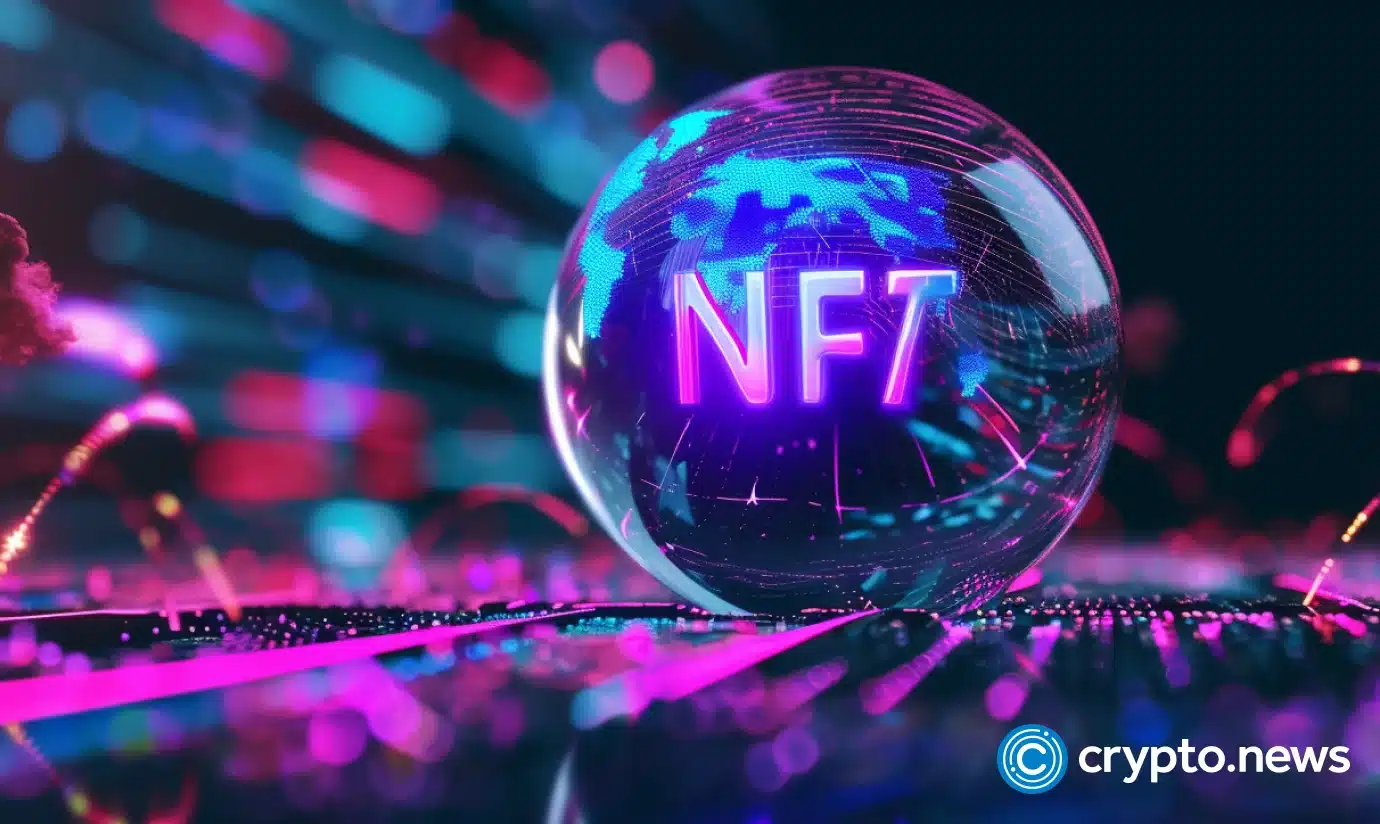
Non-fungible tokens, or NFTs, saw sales volume surge for the second week in a row, reaching $107 million, an increase of 8.5%.
A substantial increase in the number of NFT Buyers accompanied this growth, reaching 488,141 — a staggering increase of 89.56%.
On the other hand, the number of NFT sellers also increased by 69.8%, totaling 198,450, signaling an improved business environment and increased market engagement.
Below is a look at what happened in the NFT market over the past week.
Ethereum Maintains Leading Position While Solana and Bitcoin Follow
Blockchains by weekly NFT sales volume | Source: CryptoSlam
Over the past few weeks, Ethereum (ETH) continued to dominate the NFT market with $36.6 million in total sales, driven by 35,236 buyers, a 46.31% increase from the previous week.
Solana (GROUND) has emerged as a serious competitor, recording total revenue of $26.15 million, thanks to a substantial 114.07% increase in the number of buyers.
Bitcoin (Bitcoin) The NFT market also saw a notable surge, with total sales reaching $21.4 million, thanks to a staggering 222.29% increase in buyers.
Polygon (MATICS), which had the second best performance the previous week, saw its total sales volume drop by more than 15%, dropping it to 4th place just ahead of Immutable (IMX).
Other notable performances were achieved by Zora and Blast, which recorded the two largest percentage increases in sales volume, at 463% and 227% respectively.
Best Collections: Solana Monkey Business Shines
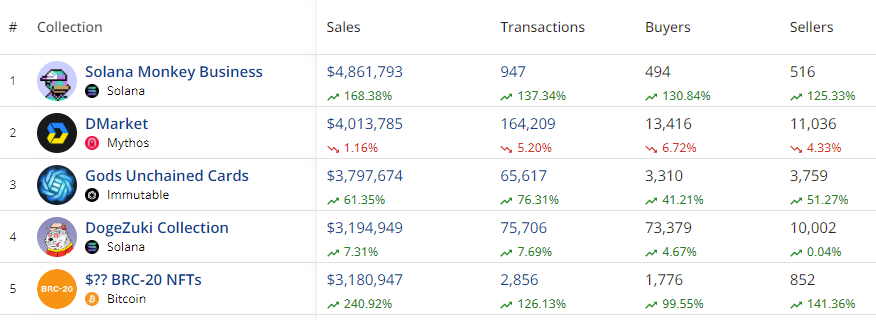 Ranking NFT collections by weekly sales volume | Source: CryptoSlam
Ranking NFT collections by weekly sales volume | Source: CryptoSlam
Among the top NFT collections, Solana Monkey Business came out on top with $4.86 million in sales, an increase of 168.38%. The collection also saw a significant increase in transactions (137.34%) and buyers (130.84%).
The DMarket collection on the Mythos blockchain, which recorded $4.01 million in sales, came in a close second. Interestingly, this is the only collection among the top 5 by sales volume to see a decline in the number of transactions and buyers.
Immutable’s Gods Unchained cards also made headlines with $3.8 million in sales, an increase of 61.35%. This collection saw notable growth in both transactions (76.31%) and buyers (41.21%), a testament to the growing popularity of blockchain-based trading cards.
Best-Selling NFTs and Fan Tokens
In terms of individual sales, Ethereum’s Autoglyphs #167 led with a sale of $274,561, followed by Bitcoin’s Protoshrooms with $148,574. Other notable sales included BNB’s kNFT: Locked kUSDT and Arbitrum’s Umoja Synths, highlighting the diversity and breadth of the NFT market across different blockchains.
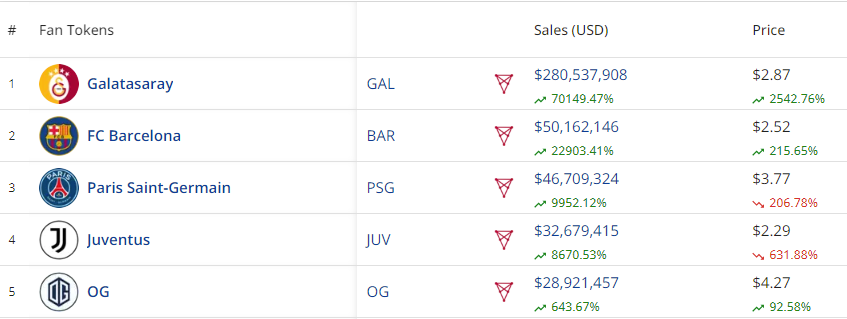 Top 5 Fan Tokens by Sales Volume
Top 5 Fan Tokens by Sales Volume
As can be seen in the table above CryptoSlamFan tokens also continued to see explosive growth, with Galatasaray’s token on the Chiliz blockchain recording a turnover of $280.5 million. This reflects an increase of 70149.47%.
FC Barcelona and Paris Saint-Germain followed with substantial sales volumes, indicating the growing popularity of sports-related NFTs.
Market consequences
The latest performance of the NFT market marks a significant turnaround, demonstrating resilience and renewed investor interest after a period of declining sales volumes.
This is the second consecutive week of improved sales, suggesting a potential upward trend. It is worth noting that this resurgence comes amid a broader recovery in the cryptocurrency market, which is currently valued at $2.55 trillion.
Major cryptocurrencies like Bitcoin, Ethereum, BNB, and Solana have all registered Prices have risen by double digits over the past week, further fueling optimism in the digital asset sector.
The correlation between rising cryptocurrency prices and the recovery of the NFT market could be an indication of strengthening investor confidence, setting a positive tone for the coming weeks.
Nfts
APENFT’s One-Day Trading Volume Hits $16.67 Million (NFT)

APENFT (NFT) fell 0.3% against the U.S. dollar in the 24-hour period ending at 9:00 a.m. ET on July 21. APENFT has a market cap of $8.54 million and $16.67 million worth of APENFT was traded on exchanges over the past day. Over the past week, APENFT has been trading 3.1% lower against the US Dollar. One APENFT token can now be purchased for around $0.0000 or 0.00000000 BTC on major cryptocurrency exchanges.
Here’s how other cryptocurrencies performed over the past day:
- KILT Protocol (KILT) is up 1.9% against the dollar and is now trading at $0.20 or 0.00000302 BTC.
- Aidi Finance (BSC) (AIDI) fell 2.2% against the dollar and is now trading at $0.0000 or 0.00000000 BTC.
- Zoo Token (ZOOT) fell 2.2% against the dollar and is now trading at $0.0652 or 0.00000239 BTC.
- CareCoin (CARES) fell 2.2% against the dollar and is now trading at $0.0809 or 0.00000297 BTC.
- Kitty Inu (KITTY) rose 1.9% against the dollar and is now trading at $95.84 or 0.00338062 BTC.
- Hokkaidu Inu (HOKK) rose 1.2% against the dollar and is now trading at $0.0004 or 0.00000001 BTC.
- Jeff in Space (JEFF) fell 2.2% against the dollar and is now trading at $2.75 or 0.00010076 BTC.
- Lumi Credits (LUMI) fell 0.7% against the dollar and is now trading at $0.0128 or 0.00000019 BTC.
- AXIA Coin (AXC) fell 0.1% against the dollar and is now trading at $13.43 or 0.00048094 BTC.
About APENFT
APENFT launched on March 28, 2021. The total supply of APENFT is 999,990,000,000,000 tokens and its circulating supply is 19,999,800,000,000 tokens. The official website of APENFT is apenft.orgThe official APENFT Twitter account is @apenftorg and his Facebook page is accessible here.
According to CryptoCompare, “APENFT is a blockchain-based platform created by the APENFT Foundation to create, buy, sell, and trade non-fungible tokens (NFTs) on the TRON and Ethereum networks. It allows for the ownership and trading of unique digital assets such as artwork, music, videos, and more. It also provides tools for artists and creators to create and promote their own NFTs, as well as participate in community events and governance.”
APENFT Token Trading
It is not currently generally possible to purchase alternative cryptocurrencies such as APENFT directly using US dollars. Investors wishing to acquire APENFT must first purchase Ethereum or Bitcoin using an exchange that deals in US dollars such as CoinbaseGDAX or Gemini. Investors can then use their newly acquired Ethereum or Bitcoin to purchase APENFT using any of the exchanges listed above.
Receive daily news and updates from APENFT – Enter your email address below to receive a concise daily summary of the latest news and updates for APENFT and associated cryptocurrencies with FREE CryptoBeat Newsletter from MarketBeat.com.
Nfts
Next US Vice President JD Vance Holds Bitcoin and NFTs, Expected to Boost MATIC and Algotech Post-Election

The blockchain technology landscape is about to transform as JD Vance, the likely next US vice president, emerges as a strong advocate for digital assets. Recent reports suggest that Vance not only holds Bitcoin (BTC) and NFTs, but is also willing to back promising blockchain initiatives like Polygon (MATIC) and Algotech (ALGT) post-elections.
JD Vance’s Cryptocurrency Investments Highlight Shift in Government Perspective
U.S. Senator JD Vance has garnered considerable attention for his recent investments in Bitcoin (BTC) and NFTs. Public records indicate that he owns between $100,000 and $250,000 worth of Bitcoin (BTC), indicating considerable interest in the success of the cryptocurrency market. This level of financial commitment from a high-profile government figure is unprecedented and underscores the growing credibility and promise of digital assets.
JD Vance’s interests extend beyond Bitcoin (BTC) to non-fungible tokens (NFTs), with reports suggesting his involvement in acquiring notable pieces from renowned collections. While the details of his NFT portfolio remain unknown, those who know the senator confirm his foray into this field.
This exploration of NFTs underscores Vance’s openness to exploring innovative and artistic applications of blockchain technology beyond cryptocurrencies’ typical role as assets or means of exchange. Vance’s involvement with cryptocurrency stands in stark contrast to the views of many of his peers in Congress, who often express doubt or hostility toward digital currency.
His direct involvement as an investor and user of these technologies gives him a unique perspective on their potential benefits and drawbacks. This practical understanding is likely to influence his stance on policy and regulation should he take on the role of vice president.
Polygon (MATIC) Hits $0.53, Eyes Breakout Amid Market Slowdown
The Vance administration, known for its support for cryptocurrencies, could significantly boost Polygon (MATIC), a major Ethereum layer 2 scaling project. MATIC has already attracted the attention of the developer community for its innovative solutions.
Even so, regulatory uncertainties have slowed widespread adoption and integration with traditional financial systems. Vance’s backing could serve as a driving force to unlock Polygon’s untapped capabilities.
A recent look at the MATIC token shows that its current trading value is $0.53, which represents an increase of over 2% in the last 24 hours. This surge coincides with a downturn in the broader cryptocurrency market, signaling solid fundamental strength and a growing sense of confidence among investors regarding Polygon’s future prospects.
Based on technical indicators, MATIC appears to be facing a resistance level that has persisted for several months, hinting at a potential breakout that could propel prices towards the previous peak around $1.29.
MATIC’s cutting-edge technology has taken a significant leap forward with the introduction of the Plonky3 zero-knowledge proof system. This innovation in zk-rollup technology is set to revolutionize MATIC’s scalability and efficiency, cementing its position as the premier choice for developers and enterprises.
Algotech (ALGT) Eyes $1 Price Hike When Its Exchange Launches
Algotech, a project that has attracted the interest of crypto enthusiasts and JD Vance, aims to transform algorithmic trading in the cryptocurrency space. Through the use of artificial intelligence and machine learning, Algotech offers advanced trading strategies to ordinary investors.
The platform’s innovative approach and ambitious roadmap are in line with JD Vance’s goal of driving financial innovation and making sophisticated investment tools more accessible to all. Algotech’s decentralized structure stands out, aligning perfectly with the core principles of blockchain technology.
By cutting out the middleman and giving users direct authority over their trading algorithms, Algotech embodies the essence of financial independence advocated by many in the crypto community, including Vance. This common ground makes Algotech a natural choice for endorsement by crypto-friendly leadership.
As Algotech’s pre-sale gains momentum, with over $9.6 million in funding, excitement is building for its official launch. Analysts have set lofty price targets, with some even suggesting that ALGT could surge to $1 shortly after it goes public.
While it’s wise to approach these predictions with caution, the combination of Algotech’s cutting-edge technology and the potential backing of key figures like JD Vance could pave the way for significant growth and adoption.
Learn more:
Disclaimer: This is a paid release. The statements, views, and opinions expressed in this column are solely those of the content provider and do not necessarily represent those of Bitcoinist. Bitcoinist does not guarantee the accuracy or timeliness of any information available in this content. Do your research and invest at your own risk.
Nfts
OG Crypto Artist Trevor Jones Unveils Groundbreaking Collection of Ordinals | NFT CULTURE | NFT News | Web3 Culture
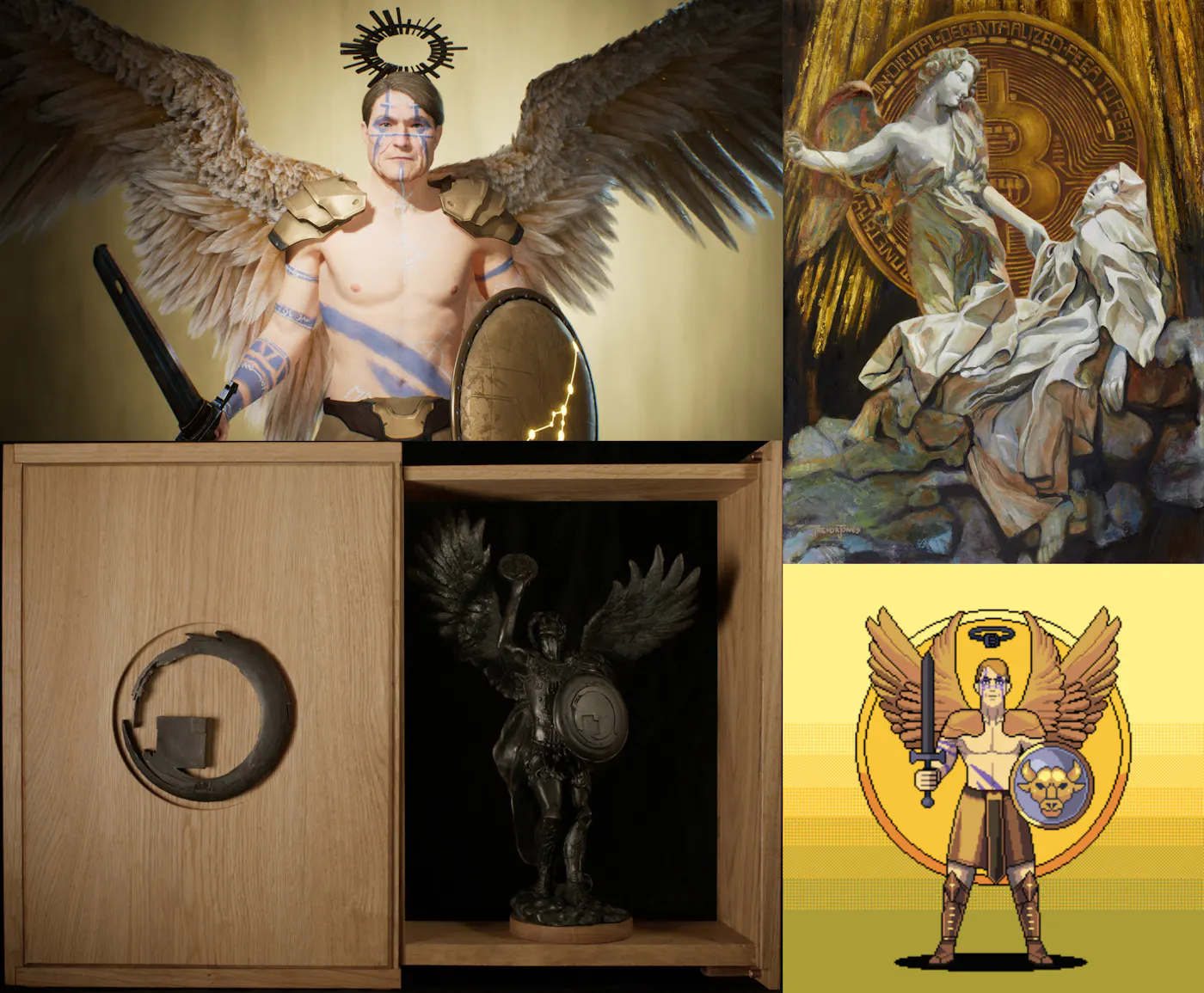
Trevor Jones’ New Genesis BTC Collection: CryptoAngels
Known for his innovative blend of physical and digital art, Trevor Jones continues to push the boundaries of the NFT space with his latest collection, CryptoAngels. Since his foray into Bitcoin-themed artwork in 2017, Jones has garnered a significant following, cementing his reputation with record-breaking sales and community events.
The Bitcoin Angel Journey
In 2021, Jones made headlines with his Bitcoin Angel open edition, selling 4,158 editions for an incredible $3.2 million in just seven minutes. This success paved the way for his latest venture, where he combines art, community, and technology in new ways. His annual Castle Parties, celebrating art, culture, and charity, have further cemented his place in the Web3 world.
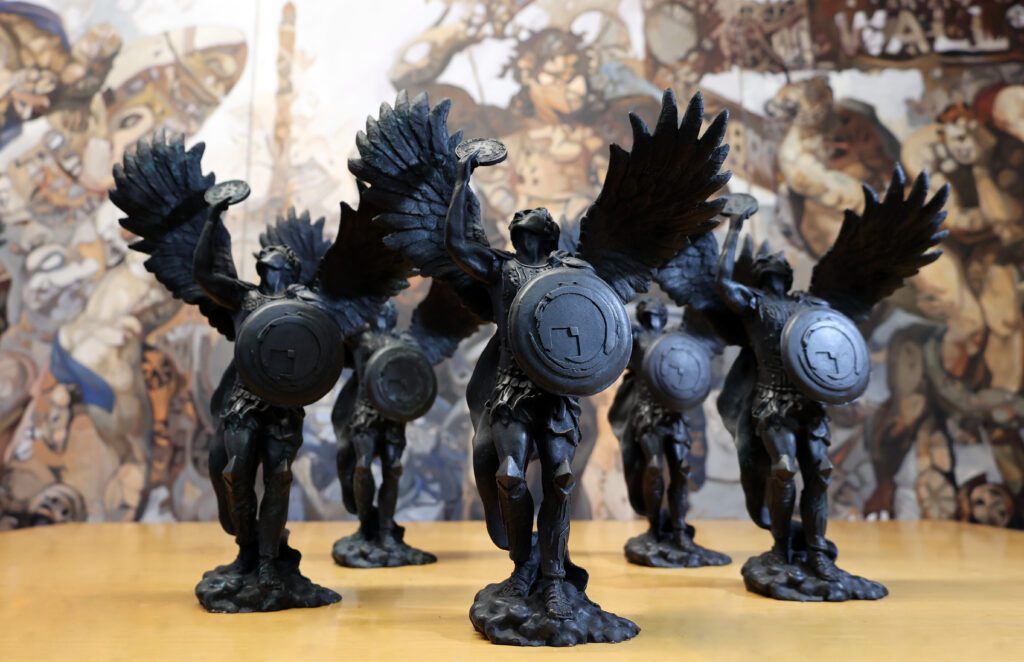
CryptoAngels Collection Review
Jones’ CryptoAngels collection is divided into two main stages: Archangels and CryptoAngels.
- Step 1: The Archangels The initial phase, Archangels, saw 21 collector’s packages sold for 87.9 ETH (approximately $335,291). Each package included:
- A physical bronze sculpture of the Bitcoin angel
- A 3D NFT avatar
- An Archangel Ordinal
Esteemed collectors like ModeratsArt, Batsoupyum, Bharat Krymo, Blondie23LMD, and 1Confirmation now lead the CryptoAngel army as Archangel Collectors.
- Step 2: CryptoAngels The second phase, set to launch on August 7, features 7,777 unique CryptoAngels. These will be available for minting via OrdinalsBot, starting with a whitelisting phase. Each CryptoAngel is distinct and named by Jones himself. The collection is organized into 21 cohorts, each associated with one of Archangel’s collectors, fostering sub-communities within the larger collection. Additionally, there are seven 1/1 CryptoAngels, making them exceptionally rare and not aligned with a cohort.
Connecting Bitcoin and Art
Jones, who has been a strong Bitcoin supporter since mid-2017, expresses his deep connection to the crypto community. He sees the CryptoAngels collection as a tribute to that community, bringing his iconic Bitcoin Angel motif to the blockchain.
“I have been personally investing in Bitcoin since mid-2017 and its ethos quickly inspired me in my crypto art journey. I have followed the growth of Ordinals since its inception and the CryptoAngels collection is my offering to a community that has welcomed me with open arms and given me the opportunity to bring my Bitcoin Angel motif to the chain where it was always meant to be,” said artist Trevor Jones.
Collectors’ opinions
“Bitcoin’s OG artist Trevor Jones, behind the Bitcoin Angels depositing ordinals on the immutable chain is a match made in crypto-native art heaven.” – Bharat Krymo (@krybharat – Archangel Collector)
“The 2018 Bitcoin Angel oil painting is one of the first crypto tributes to Bitcoin, so CryptoAngels on Ordinals is a natural extension of Trevor’s artistic journey” – batsoupyum (Archangel Collector)
Interactive experience and limited editions
Rounding out the collection, 21 special Angels will be available to mint for $7 each on Base, playable in the exclusive retro arcade game, Dante’s Pixel Inferno. The game challenges players to guide their Angel through the nine circles of Fiat Hell, collecting Bitcoin and earning rewards. Each Angel in the game has unique abilities and weapons.
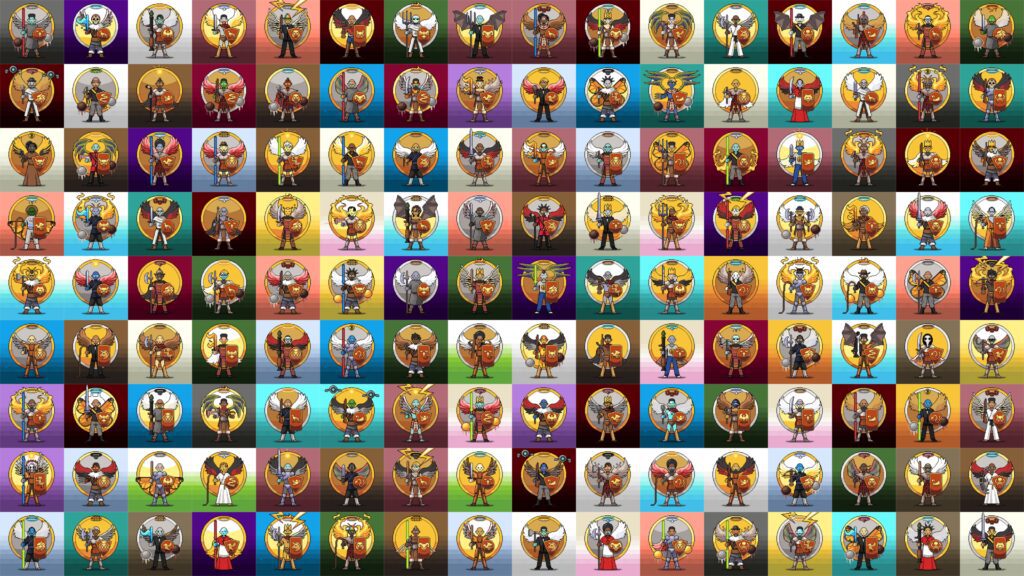

Whitelisting Opportunities and Community Engagement
Whitelisting (WL) opportunities are available through community partnerships, existing Bitcoin Angel OE and Trevor’s Ascended Angels holders, and weekly giveaways. To stay up to date and secure a spot on the whitelist, join Trevor Jones’ active Discord community.
TL;DR
Trevor Jones is launching the CryptoAngels collection on August 7th, building on his Bitcoin Angel legacy. Split into two stages, Archangels and CryptoAngels, the collection includes unique NFTs and physical artworks, fostering strong community connections. Exclusive gaming experiences and limited minting opportunities enhance engagement. Join the Discord for your chance to win.
-

 Nfts1 year ago
Nfts1 year agoShardLab Launches ZK-Based Tool for Digital Identity and NFT Vouchers
-

 News1 year ago
News1 year agoWallet recovery firms are abuzz as stranded cryptocurrency investors panic in the bitcoin boom
-

 Bitcoin1 year ago
Bitcoin1 year agoBitcoin, Ethereum, Solana and Cryptocurrency Markets Look Ready to ‘Send’ as Stars Align, According to Investor Chris Burniske
-

 Altcoins1 year ago
Altcoins1 year agoThree Altcoins Poised for Significant Growth in 2024: ETFS, OP, BLAST
-

 Altcoins1 year ago
Altcoins1 year agoAccumulate these altcoins now for maximum gains
-

 Nfts1 year ago
Nfts1 year agoOG Crypto Artist Trevor Jones Unveils Groundbreaking Collection of Ordinals | NFT CULTURE | NFT News | Web3 Culture
-

 Bitcoin1 year ago
Bitcoin1 year agoBillionaires are selling Nvidia stock and buying an index fund that could rise as much as 5,655%, according to some Wall Street analysts
-

 Videos9 months ago
Videos9 months agoKamala just won the boner! [Bad For Crypto]
-

 Videos1 year ago
Videos1 year agoLIVE FOMC 🚨 Could be CATASTROPHIC for Altcoins!
-

 News1 year ago
News1 year agoA Guide for Newcomers & Beginners – Forbes Advisor
-

 Videos1 year ago
Videos1 year agoAttention: a historically significant BITCOIN signal has just appeared!
-

 Videos1 year ago
Videos1 year agoSTOCK MARKET FUD! ⚠️ [Why This Is GREAT For Bitcoin Traders!]




